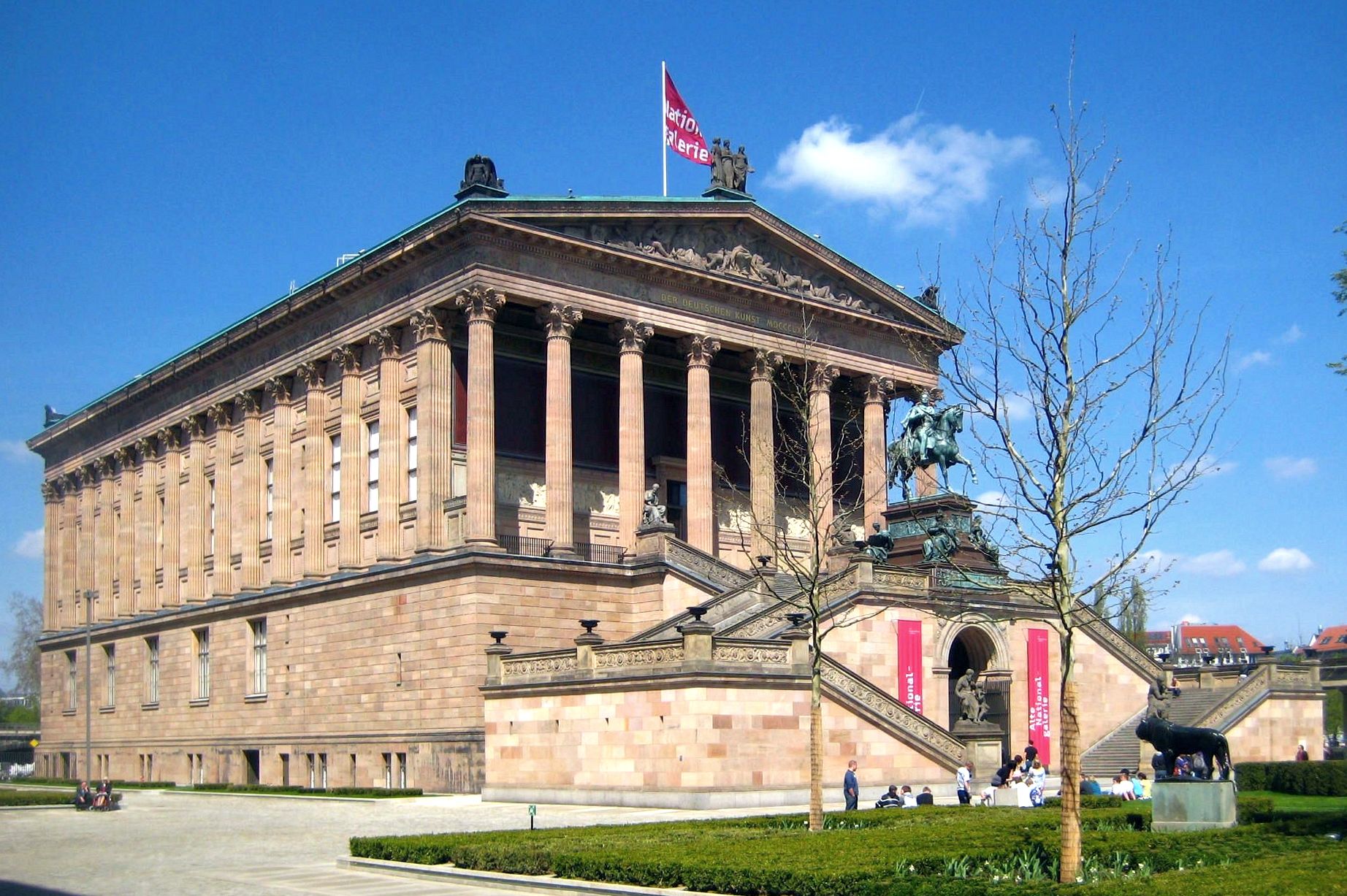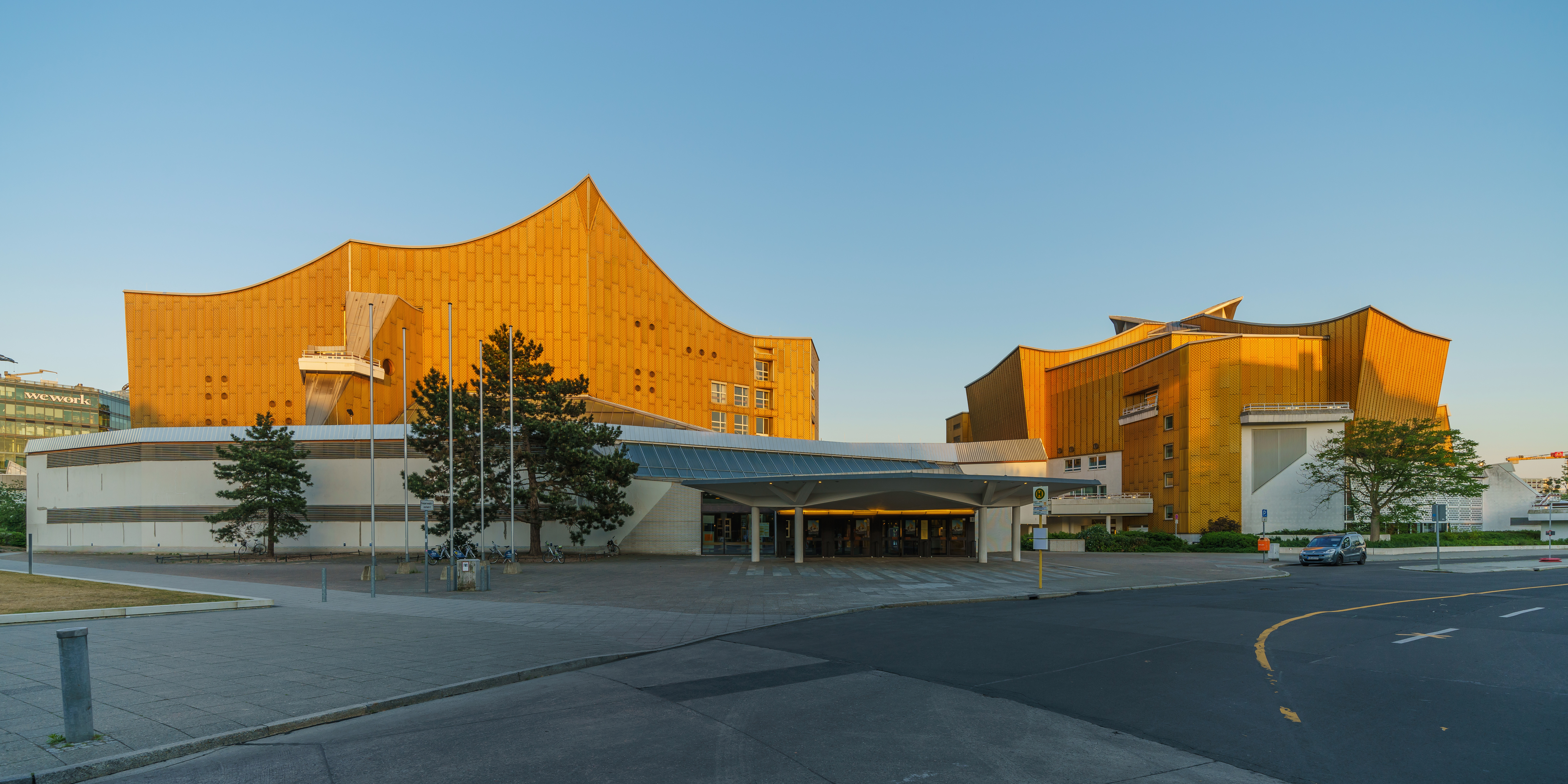|
Nationalgalerie
The National Gallery (german: Nationalgalerie) in Berlin, Germany, is a museum for art of the 19th, 20th and 21st centuries. It is part of the Berlin State Museums. From the Alte Nationalgalerie, which was built for it and opened in 1876, its exhibition space has expanded to include five other locations. The museums are part of the Berlin State Museums, owned by the Prussian Cultural Heritage Foundation. Locations The holdings of the National Gallery are currently shown in five locations: * Alte Nationalgalerie: 19th-century art, on Museum Island * Neue Nationalgalerie: 20th-century art, at the Kulturforum. The building, designed by Ludwig Mies van der Rohe, opened on 15 September 1968. * Berggruen Museum: in Charlottenburg, showing classics of 20th-century modern art collected by Heinz Berggruen; added to the National Gallery in 1996. * Scharf-Gerstenberg Collection: in Charlottenburg, showing 20th-century art from French Romanticism to Surrealism; added to the National G ... [...More Info...] [...Related Items...] OR: [Wikipedia] [Google] [Baidu] |
Neue Nationalgalerie
The Neue Nationalgalerie (New National Gallery) at the Kulturforum is a museum for modern art in Berlin, with its main focus on the early 20th century. It is part of the National Gallery of the Berlin State Museums. The museum building and its sculpture gardens were designed by Ludwig Mies van der Rohe and opened in 1968. The gallery closed in 2015 for renovation. The work, by David Chipperfield Architects, was completed in 2021, and the museum reopened in August 2021 with an exhibition of works by American sculptor Alexander Calder. Collection The collection features a number of unique highlights of modern 20th-century art. Particularly well represented are Cubism, Expressionism, the Bauhaus and Surrealism. The collection owns masterpieces of artists like Pablo Picasso, Ernst Ludwig Kirchner, Joan Miró, Wassily Kandinsky and Barnett Newman. The design of the building, despite its large size, allows for the display of only a small part of the collection, and the displays are ... [...More Info...] [...Related Items...] OR: [Wikipedia] [Google] [Baidu] |
Alte Nationalgalerie
The Alte Nationalgalerie ( ''Old National Gallery'') is a listed building on the Museum Island in the Mitte (locality), historic centre of Berlin, Germany. The gallery was built from 1862 to 1876 by the order of King Frederick William IV of Prussia according to plans by Friedrich August Stüler and Johann Heinrich Strack in Neoclassical architecture, Neoclassical and Renaissance Revival architecture, Renaissance Revival styles. The building's outside stair features a memorial to Frederick William IV. Currently, the Alte Nationalgalerie is home to painting, paintings and sculpture, sculptures of the 19th century and hosts a variety of tourist buses daily. As part of the Museum Island complex, the gallery was inscribed on the UNESCO World Heritage List in 1999 for its outstanding architecture and its testimony to the development of museums and galleries as a cultural phenomenon in the late 19th century. History Founding The first impetus to founding a national gallery came in 181 ... [...More Info...] [...Related Items...] OR: [Wikipedia] [Google] [Baidu] |
Joachim Heinrich Wilhelm Wagener
Joachim Heinrich Wilhelm Wagener (16 July 1782 in Berlin – 18 January 1861 in Berlin) was a German banker and patron of the arts. His collection formed the initial nucleus of the Alte Nationalgalerie in Berlin. Life and work [Baidu] |
Museum Island
The Museum Island (german: Museumsinsel) is a museum complex on the northern part of the Spree Island in the historic heart of Berlin. It is one of the most visited sights of Germany's capital and one of the most important museum sites in Europe. Built from 1830 to 1930 by order of the Prussian Kings according to plans by five architects, Museum Island was designated a UNESCO World Heritage Site in 1999 because of its testimony to the architectural and cultural development of museums in the 19th and 20th centuries. It consists of the Altes Museum, the Neues Museum, the Alte Nationalgalerie, the Bode-Museum and the Pergamonmuseum. As Museum Island includes all of Spree Island north of the Unter den Linden, the Berliner Dom is also located here, near the Lustgarten. To the south, the reconstructed Berlin Palace houses the Humboldt Forum museum and opened in 2020. Since German reunification, the Museum Island has been rebuilt and extended according to a master plan. In 2019, a new ... [...More Info...] [...Related Items...] OR: [Wikipedia] [Google] [Baidu] |
Kulturforum
The Kulturforum ( en, Cultural Forum) is a collection of cultural buildings in Berlin. It was built up in the 1950s and 1960s at the edge of West Berlin, after most of the once unified city's cultural assets had been lost behind the Berlin Wall. The Kulturforum is characterized by its innovative modernist architecture; several buildings are distinguished by the organic designs of Hans Scharoun, and the Neue Nationalgalerie was designed by Mies van der Rohe. Today, the Kulturforum lies immediately to the west of the redeveloped commercial node of Potsdamer Platz. Cultural institutions Among the cultural institutions housed in and around the Kulturforum are: *Neue Nationalgalerie * Gemäldegalerie *Kunstgewerbemuseum Berlin (Museum of Decorative Arts) * Musical Instrument Museum * Kupferstichkabinett (Print room) *Kunstbibliothek Berlin (Berlin Art Library) *Berliner Philharmonie * Chamber Music Hall *Berlin State Library ''Haus Potsdamer Straße'' *Ibero-American Institute * Wis ... [...More Info...] [...Related Items...] OR: [Wikipedia] [Google] [Baidu] |
Prussia
Prussia, , Old Prussian: ''Prūsa'' or ''Prūsija'' was a German state on the southeast coast of the Baltic Sea. It formed the German Empire under Prussian rule when it united the German states in 1871. It was ''de facto'' dissolved by an emergency decree transferring powers of the Prussian government to German Chancellor Franz von Papen in 1932 and ''de jure'' by an Allied decree in 1947. For centuries, the House of Hohenzollern ruled Prussia, expanding its size with the Prussian Army. Prussia, with its capital at Königsberg and then, when it became the Kingdom of Prussia in 1701, Berlin, decisively shaped the history of Germany. In 1871, Prussian Minister-President Otto von Bismarck united most German principalities into the German Empire under his leadership, although this was considered to be a "Lesser Germany" because Austria and Switzerland were not included. In November 1918, the monarchies were abolished and the nobility lost its political power during the Ger ... [...More Info...] [...Related Items...] OR: [Wikipedia] [Google] [Baidu] |
Prussian Cultural Heritage Foundation
The Prussian Cultural Heritage Foundation (german: Stiftung Preußischer Kulturbesitz; SPK) is a German federal government body that oversees 27 museums and cultural organizations in and around Berlin, Germany. Its purview includes all of Berlin's State Museums, the Berlin State Library, the Prussian Privy State Archives and a variety of institutes and research centers. As such, it is one of the largest cultural organizations in the world, and also the largest cultural employer in Germany with around 2,000 staff as of 2020. More than four million people visited its museums in 2019. The SPK was established in 1957 with the mission to acquire and preserve the cultural legacy of the former State of Prussia. Its current operations include the preservation and care of the museum collections and the continuation of academic and scientific research to encourage learning and understanding between different peoples. In July 2020, Federal Government Commissioner for Culture and the Media Mo ... [...More Info...] [...Related Items...] OR: [Wikipedia] [Google] [Baidu] |
Berlin State Museums
The Berlin State Museums (german: Staatliche Museen zu Berlin) are a group of institutions in Berlin, Germany, comprising seventeen museums in five clusters, several research institutes, libraries, and supporting facilities. They are overseen by the Prussian Cultural Heritage Foundation and funded by the German federal government in collaboration with Germany's federal states. The central complex on Museum Island was added to the UNESCO list of World Heritage Sites in 1999. By 2007, the Berlin State Museums had grown into the largest complex of museums in Europe. The museum was originally founded by King Friedrich Wilhelm III of Prussia in 1823 as the Königliche Museen (in English, Royal Museums). The director-general of the Berlin State Museums is Michael Eissenhauer. Museum locations Berlin-Mitte * Museum Island ** Altes Museum: Roman and Greek Classical Antiquities ** Alte Nationalgalerie: 19th century sculptures and paintings. ** Bode-Museum: the Numismatic C ... [...More Info...] [...Related Items...] OR: [Wikipedia] [Google] [Baidu] |
Equestrian Statue Of Frederick William IV
The equestrian statue of Frederick William IV is an 1875–86 sculpture of Frederick William IV of Prussia by Alexander Calandrelli, installed in front of the Alte Nationalgalerie in Berlin, Germany. . erl ... [...More Info...] [...Related Items...] OR: [Wikipedia] [Google] [Baidu] |
Friedrichswerder Church
Friedrichswerder Church (german: Friedrichswerdersche Kirche, french: Temple du Werder) was the first Neo-Gothic church built in Berlin, Germany. It was designed by an architect better known for his Neoclassical architecture, Karl Friedrich Schinkel, and was built under his direction from 1824 to 1831. The building is maintained by the Prussian Cultural Heritage Foundation and is part of the Berlin State Museums' ensemble. In late 2012, the building was closed due to structural damage caused by nearby construction. After extensive restoration work completed in early October 2019, the damage was repaired and exhibitions from the Alte Nationalgalerie (the Old National Gallery) returned. These include a collection of nineteenth-century German sculptures, showing works of Johann Gottfried Schadow, Karl Friedrich Schinkel and Christian Daniel Rauch, among others. On the upper floor is an exhibition of the work and life of Karl Friedrich Schinkel. References Gallery Berlin church of ... [...More Info...] [...Related Items...] OR: [Wikipedia] [Google] [Baidu] |
Friedrich August Stüler
Friedrich August Stüler (28 January 1800 – 18 March 1865) was an influential Prussian architect and builder. His masterpiece is the Neues Museum in Berlin, as well as the dome of the triumphal arch of the main portal of the Berliner Schloss. Life Stüler was born on 28 January 1800 in Mühlhausen. In 1818 he started studying architecture and became a student of Karl Friedrich Schinkel in Berlin. After travelling to France and Italy together with Eduard Knoblauch in 1829 and 1830 and to Russia together with Heinrich Strack in 1831, Stüler became ''Hofbauinspektor'' (Royal Buildings Inspector), ''Hofbaurat'' (Royal privy councillor for buildings) and director of the commission for the building of the Berliner Stadtschloss in 1832. In 1837, he planned the rebuilding of the Winter Palace in Saint Petersburg, but failed to realise these plans because Tsar Nicholas I of Russia decided to rebuild the original Baroque/Rococo palace instead of Stülers Neo-Renaissance concept. Stüle ... [...More Info...] [...Related Items...] OR: [Wikipedia] [Google] [Baidu] |
Prussian Academy Of Arts
The Prussian Academy of Arts (German: ''Preußische Akademie der Künste'') was a state arts academy first established in Berlin, Brandenburg, in 1694/1696 by prince-elector Frederick III, in personal union Duke Frederick I of Prussia, and later king in Prussia. After the Accademia dei Lincei in Rome and the Académies Royales in Paris, the Prussian Academy of Art was the oldest institution of its kind in Europe, with a similar mission to other royal academies of that time, such as the Real Academia Española in Madrid, the Royal Society in London, or the Royal Swedish Academy of Fine Arts in Stockholm. The academy had a decisive influence on art and its development in the German-speaking world throughout its existence. For an extended period of time it was also the German artists' society and training organisation, whilst the Academy's Senate became Prussia's arts council as early as 1699. It dropped 'Prussian' from its name in 1945 and was finally disbanded in 1955 after ... [...More Info...] [...Related Items...] OR: [Wikipedia] [Google] [Baidu] |






